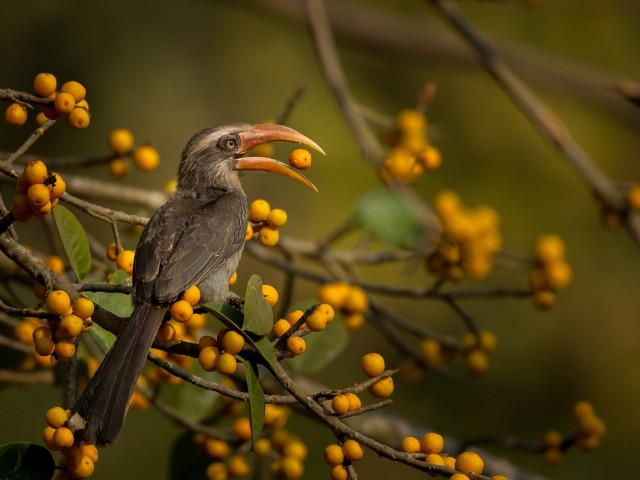This is the third story in a series of articles on frugivory and seed dispersal, leading up to the FSD 2020 symposium in March next year.
The whooshing sound of hornbill wings, their loud cackling calls, and even the occasional sight of a huge flock of them flying out of a large fruiting Ficus (fig) tree are a quintessential part of a walk through the protected tropical forests of South and South-east Asia. Tropical trees and fruit-eating animals are intricately linked — the animals benefit from the nutrients in the fruits, and the seeds dispersed by the animals benefit from lowered predation and competition pressures. However, not all forests in South and South-east Asia offer such breathtaking sights of large birds flying up in the canopy anymore. Human impacts such as hunting and logging are interfering with these delicate plant-animal relationships.
In 2008, I started the fieldwork for my PhD in a village in the Lower Dibang Valley district of Arunachal Pradesh. On my very first day in the forests of Dibang, I was greeted by the sound of gunshots and the sight of plucked hornbill feathers strewn across the forest floor. That night I decided to visit the numerous households and count the number of hornbills that had been shot for the pot during the day. After three households and nine dead Wreathed Hornbills, I gave up. I couldn’t take the sight of freshly dismembered hornbill heads anymore.
After my travels, across several districts of Arunachal Pradesh, I realized that places like Namdapha and Pakke Tiger Reserves with relatively high hornbill densities were few and far between. Hunting was prevalent across the state of Arunachal Pradesh, which otherwise had extensive forest cover and offered excellent habitats for hornbills. Hornbills occurred in lower numbers in sites outside protected areas and locals even reported the local extinction of larger hornbills from a few protected area sites. Larger hornbills raise a single chick a year, making them extremely vulnerable to hunting.
Hornbills are often referred to as ‘farmers of the forest’. They are known to disperse seeds and aid in the regeneration of tropical trees by enabling the seeds to escape from competition with the parent plant and siblings, as well as from the predation of rodents, invertebrates and fungi that they would otherwise experience under the mother plant.
I aimed to find out how many seeds hornbills ‘plant’ in these forests and what happens to these trees once hornbills are lost from the ecosystem due to threats like logging and hunting. We found that in the forests with very high densities of hornbills, like the Namdapha Tiger Reserve, they could be dispersing more than 11,000 seeds per day per sq. km. The site, Namdapha Tiger Reserve, where the study was carried out, is an exceptional forest. Hornbill densities reported from Namdapha are among the highest in Asia.
However, as one would expect, fewer hornbills occur in forests where hunting is prevalent. Moreover, hunting and logging co-occur in most of the tropical forests in Asia and are closely linked to both the fate of the dispersers such as hornbills as well as the forests. To determine the impacts of logging and hunting, we compared an undisturbed site (Namdapha Tiger Reserve) with a site that experienced both hunting and logging (Miao Reserved Forest).
You may also like to read
We found that most of the important hornbill food plants, particularly Canarium strictum and Phoebe sp., were also commercially important targets for loggers. They are two of the key food species in a hornbill diet during the breeding season. Logging took a huge toll on the abundance of hornbill food plants — their abundance was twice in the protected site (Namdapha Tiger Reserve) as compared to the disturbed site (Miao Reserved Forest). Logging and hunting negatively affected hornbill abundances — encounters of hornbills were 22 times higher in the protected site than in the disturbed site. And, the number of dispersed seeds on the forest floor was seven times higher in the protected site than in the disturbed site. This highlighted the compromised seed dispersal services in the disturbed site because of loss of fruiting trees and frugivores. In two of the four large-seeded plant species for which we examined recruitment, the number of saplings of all size classes was lower in disturbed site than in the protected site, highlighting the poor regeneration of these species, likely because of loss of fruiting plants and dispersers.
Given that logging and hunting are widespread in North-east India, we have come to understand that the loss of large-bodied frugivores like hornbills can have direct negative consequences on plant regeneration by negatively affecting the number of seeds that are dispersed in the forests. This could also alter the nature of resource availability for both animals and humans (who are economically dependent on these species) in the long-term. In this region, Wreathed Hornbills move from lowland forests to higher areas in the non-breeding season to track peak fruit availability, particularly of plants like Canarium strictum and Phoebe sp. that are targeted by logging. Logging and hunting can permanently disrupt such intricate relationships between plants and frugivores, with long-term implications for tree regeneration.
The original paper can be found here.







